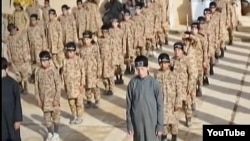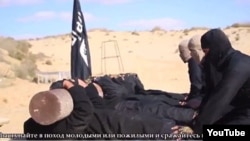The Islamic State (IS) is bombarding social media with Russian language propaganda aimed at attracting new recruits from targeted audiences.
The media barrage appeared to intensify after Russia entered the Syrian civil war last September to help prop up the regime of President Bashar al-Assad. While it is hard to measure the campaign’s success, Russia has taken steps to block Islamic State's online messaging. Despite the measures, IS continues to target disenfranchised youth, radicalized women and jihadists it believes are willing to join the IS cause.
According to the Russian government, more than 4,000 Russian citizens have traveled to Iraq and Syria to fight alongside various jihadist groups, including IS. Central Asian nations also report high levels of influence and recruitment by the jihadists, with estimates of the number of recruits who have joined ranging from several hundred to several thousand.
The percentage of women among the recruits is also not declining, government officials say.
Russian-language IS propaganda is proliferating online despite efforts by social network and domain administrators to block it. It is aimed at Russian-speaking Muslim communities globally and reaches urban centers and remote rural villages. Experts say young people and single mothers are the most vulnerable targets.
One recent video shows children playing joyfully on a sunny day, surrounded by adults, all of them long-bearded men, some of them carrying Kalashnikovs, others tasting freshly roasted barbecue. There are also little boys playing with real pistols, elders praising Allah for the blessed peace of the Islamic State, and young men kneeling in a group Muslim prayer on the streets. No adult women or teenage girls appear during the 12-minute video.
Cannon fodder
Another recent IS video is full of scenes of war, accompanied by quotes from the Quran exhorting “the lazy” to come and fight. It promises salvation and rewards in heaven to those who answer the call to jihad, and "eternal hell" for those who ignore it.
More so than in the past, Russian-language IS propaganda videos are more narrowly focused on and specially narrated for certain target audiences. Videos specifically aimed at drawing in Muslim families tout the rewards of living under Sharia law, while martial arts videos aimed at youth dreaming of heroic adventures feature fierce combat, victorious attacks and humiliated captives, all ending with a young fighter calling on viewers to join the ranks.
“The youngsters are obsessed with IS videos practically everywhere, and are material for cannon fodder,” Orkhan Dzhemal, a reporter with independent Russian television station TV Dozhd (Rain), told VOA.
Dzhemal's reporting from the Middle East, Central Asia and the North Caucasus has earned him a level of trust among Salafists, adherents of a more puritan, Saudi-style branch of Islam that the governments of Russia and some Central Asian nations considers a “dangerous” form of Islam and openly persecute.
Professional production values
Since the emergence of a Russian-speaking Islamic State contingent, IS video/audio production has gone from amateurish to “professional”, produced by a newly established team of Russian-speaking IS propagandists. Since mid-2015 the produced material is much more sophisticated technologically, and includes a daily radio news program and a flood of propaganda videos.
Some of the videos are simply translated or subtitled versions of Arabic language IS video-clips.
Some are produced by the Russian-speaking IS team. Often nearly an hour long, many include footage of Russian troops during the two Chechen wars and calls for Muslims to take revenge. These videos, which often focus on episodes from the history of Russia's colonization of the North Caucasus, display relatively advanced filmmaking skills. They frequently feature figures popular among radical-minded Muslims in the North Caucasus and in Central Asia, who tell stories about living and fighting in the IS "caliphate" and urge viewers to join.
Finding social media users
Russian-language IS websites and accounts emerge and disappear, sometimes on the same day, because social network and domain administrators quickly shut them down. But these short-lived online propaganda projects come with a back-up plan: there are “how not to lose us” links pinned to the top of each page. These links usually lead to mirror accounts, decoded file sharing sites and the Telegram app.
Created in 2013 by two Russian IT developers, brothers Nikolai and Pavel Durov, this cloud-based instant messenger, with optional “secret chats” equipped with a self-destruct timer, had 100 million active users worldwide as of February 2016.
Russia's security services say Telegram remains one of the biggest challenges to fighting IS online. But there is nothing that prevents compiling a database of the names of those who use the app and those with whom they are communicating.
To track extremist groups on the Internet, Russian security and intelligence services use a program called Avalanche. The program makes it possible to collect data on terrorist recruitment and financing. Special filters and keywords allow the program to track correspondence in e-mail, social media, mobile phone messages, and in chat rooms of online computer games.
But while the Russian government says that tens of thousands of domains, blogs and social media accounts are being blocked or banned every day, Russian-language Islamic State propaganda continues to appear and multiply.










